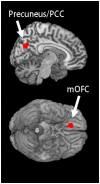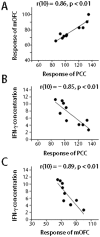Brain-immune interaction accompanying odor-evoked autobiographic memory
- PMID: 23977312
- PMCID: PMC3748042
- DOI: 10.1371/journal.pone.0072523
Brain-immune interaction accompanying odor-evoked autobiographic memory
Abstract
The phenomenon in which a certain smell evokes a specific memory is known as the Proust phenomenon. Odor-evoked autobiographic memories are more emotional than those elicited by other sensory stimuli. The results of our previous study indicated that odor-evoked autobiographic memory accompanied by positive emotions has remarkable effects on various psychological and physiological activities, including the secretion of cytokines, which are immune-signaling molecules that modulate systemic inflammation. In this study, we aimed to clarify the neural substrates associated with the interaction between odor-evoked autobiographic memory and peripheral circulating cytokines. We recruited healthy male and female volunteers and investigated the association between brain responses and the concentration of several cytokines in the plasma by using positron emission tomography (PET) recordings when an autographic memory was evoked in participants by asking them to smell an odor that was nostalgic to them. Participants experienced positive emotions and autobiographic memories when nostalgic odors were presented to them. The levels of peripheral proinflammatory cytokines, such as the tumor necrosis factor-α (TNF-α) and interferon-γ (IFN-γ), were significantly reduced after experiencing odor-evoked autobiographic memory. Subtraction analysis of PET images indicated that the medial orbitofrontal cortex (mOFC) and precuneus/posterior cingulate cortex (PCC) were significantly activated during experiences of odor-evoked autobiographic memory. Furthermore, a correlation analysis indicated that activities of the mOFC and precuneus/PCC were negatively correlated with IFN-γ concentration. These results indicate that the neural networks including the precuneus/PCC and mOFC might regulate the secretion of peripheral proinflammatory cytokines during the experience of odor-evoked autobiographic memories accompanied with positive emotions.
Conflict of interest statement
Figures



Similar articles
-
Psychological and physiological responses to odor-evoked autobiographic memory.Neuro Endocrinol Lett. 2011;32(6):774-80. Neuro Endocrinol Lett. 2011. PMID: 22286798
-
Odor-induced recall of emotional memories in PTSD-Review and new paradigm for research.Exp Neurol. 2016 Oct;284(Pt B):168-180. doi: 10.1016/j.expneurol.2016.08.001. Epub 2016 Aug 7. Exp Neurol. 2016. PMID: 27511295 Review.
-
The proust effect: Scents, food, and nostalgia.Curr Opin Psychol. 2023 Apr;50:101562. doi: 10.1016/j.copsyc.2023.101562. Epub 2023 Feb 9. Curr Opin Psychol. 2023. PMID: 36863096 Review.
-
Odor-evoked memories: The importance of choosing the right odor.Acta Psychol (Amst). 2023 Jun;236:103932. doi: 10.1016/j.actpsy.2023.103932. Epub 2023 May 8. Acta Psychol (Amst). 2023. PMID: 37163884
-
The functional neuroanatomy of odor evoked autobiographical memories cued by odors and words.Neuropsychologia. 2013 Jan;51(1):123-31. doi: 10.1016/j.neuropsychologia.2012.10.023. Epub 2012 Nov 9. Neuropsychologia. 2013. PMID: 23147501
Cited by
-
Olfactory Virtual Reality: A New Frontier in the Treatment and Prevention of Posttraumatic Stress Disorder.Brain Sci. 2021 Aug 16;11(8):1070. doi: 10.3390/brainsci11081070. Brain Sci. 2021. PMID: 34439689 Free PMC article.
-
Inflammation and olfactory loss are associated with at least 139 medical conditions.Front Mol Neurosci. 2024 Oct 11;17:1455418. doi: 10.3389/fnmol.2024.1455418. eCollection 2024. Front Mol Neurosci. 2024. PMID: 39464255 Free PMC article.
-
Patterns of brain activity associated with nostalgia: a social-cognitive neuroscience perspective.Soc Cogn Affect Neurosci. 2022 Dec 1;17(12):1131-1144. doi: 10.1093/scan/nsac036. Soc Cogn Affect Neurosci. 2022. PMID: 35560158 Free PMC article.
-
Harmonizing the past: EEG-based brain network unveil modality-specific mechanisms of nostalgia.Front Psychol. 2025 Jan 22;16:1517449. doi: 10.3389/fpsyg.2025.1517449. eCollection 2025. Front Psychol. 2025. PMID: 39911992 Free PMC article.
-
Neural Networks Implicated in Autobiographical Memory Training.eNeuro. 2022 Nov 30;9(6):ENEURO.0137-22.2022. doi: 10.1523/ENEURO.0137-22.2022. Print 2022 Nov-Dec. eNeuro. 2022. PMID: 36411054 Free PMC article.
References
-
- Proust M (1919) Du coté de chez Swann. Paris: Gaillimard.
-
- Herz RS, Cupchik GC (1995) The emotional distinctiveness of odor-evoked memories. Chem Sens 20: 517-528. doi:10.1093/chemse/20.5.517. PubMed: 8564426. - DOI - PubMed
-
- Herz RS (1998) Are odors the best cues to memory? A cross-modal comparison of associative memory stimuli. Ann N Y Acad Sci 855: 670-674. doi:10.1111/j.1749-6632.1998.tb10643.x. PubMed: 9929669. - DOI - PubMed
-
- Herz RS, Schooler JW (2002) A naturalistic study of autobiographical memories evoked by olfactory and visual cues: testing the Proustian hypothesis. Am J Psychol 115: 21-32. doi:10.2307/1423672. PubMed: 11868193. - DOI - PubMed
-
- Herz RS, Eliassen J, Beland S, Souza T (2004) Neuroimaging evidence for the emotional potency of odor-evoked memory. Neuropsychologia 42: 371-378. doi:10.1016/j.neuropsychologia.2003.08.009. PubMed: 14670575. - DOI - PubMed
Publication types
MeSH terms
Substances
LinkOut - more resources
Full Text Sources
Other Literature Sources

